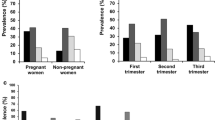Abstract
Background/Aim: To assess the status of 25-hydroxyvitamin D [25(OH)D] in pregnant women in their second and third trimesters, who reside and work indoors in Guiyang, China. Subjects and methods: A total of 311 pregnant women in their 12th to 40th gestational week were engaged in employment located indoors in the urban area of Guiyang and completed a questionnaire on living habits. Levels of serum 25(OH)D were measured from fasting venous blood by liquid chromatography-mass spectrometry (LC-MS/MS). Levels of 25(OH)D were classified as vitamin D deficient [25(OH)D<20 ng/ml], insufficient [20 ng/ml≤25(OH)D<30 ng/ml], or sufficient [25(OH)D≥30 ng/ml]. Results: The mean serum level of 25(OH)D was 14.69±6.81 ng/ml. Vitamin D deficiency, insufficiency and sufficiency were found in 260 (83.6%), 39 (12.5%), and 12 (3.9%) women, respectively. The mean level of 25(OH)D in the third trimester was significantly higher than in the second trimester (p<0.001). The mean 25(OH)D level in summer (June, July, August) was significantly higher than in the other seasons (p<0.001). The 25(OH)D level in pregnant women compliant with pre-natal calcium or multivitamin supplements was higher than in those not taking supplements (p<0.001). Conclusions: These results suggest that pregnant women residing in Guiyang urban area and working indoors are at high risk of vitamin D insufficiency, particularly during spring, winter, and autumn, regardless of use of pre-natal calcium and multivitamins. Appropriate vitamin D supplementation is necessary to improve maternal vitamin D nutrition.
Similar content being viewed by others
References
Lee JH, O’Keefe JH, Bell D, Hensrud DD, Holick MF. Vitamin D deficiency an important, common, and easily treatable cardiovascular risk factor?. J Am Coll Cardiol 2008, 52: 1949–56.
Holick MF. Vitamin D deficiency. N Engl J Med 2007, 357: 266–81.
Holick MF, Binkley NC, Bischoff-Ferrari HA, et al. Evaluation, treatment, and prevention of vitamin D deficiency: an Endocrine Society clinical practice guideline. J Clin Endocrinol Metab 2011, 96: 1911–30.
Bowyer L, Catling-Paull C, Diamond T, Homer C, Davis G, Craig ME. Vitamin D, PTH and calcium levels in pregnant women and their neonates. Clin Endocrinol (Oxf) 2009, 70: 372–7.
Maghbooli Z, Hossein-Nezhad A, Karimi F, Shafaei AR, Larijani B. Correlation between vitamin D3 deficiency and insulin resistance in pregnancy. Diabetes Metab Res Rev 2008, 24: 27–32.
Baker AM, Haeri S, Camargo CA Jr, Espinola JA, Stuebe AM. A nested case-control study of midgestation vitamin D deficiency and risk of severe preeclampsia. J Clin Endocrinol Metab 2010, 95: 5105–9.
Arunabh S, Pollack S, Yeh J, Aloia JF. Body fat content and 25-hydroxyvitamin D levels in healthy women. J Clin Endocrinol Metab 2003, 88: 157–61.
Yorifuji J, Yorifuji T, Tachibana K, et al. Craniotabes in normal newborns: the earliest sign of subclinical vitamin D deficiency. J Clin Endocrinol Metab 2008, 93: 1784–8.
Liao EY. Vitamin D, In: Liao EY ed. Metabolic osteology. Beijing: People’s Medical Publishing House. 2003, 122–44.
DeLuca HF. Overview of general physiologic features and functions of vitamin D. Am J Clin Nutr 2004, 80: 1689S–96S.
Wagner CL, Taylor SN, Dawodu A, Johnson DD, Hollis BW. Vitamin D and its role during pregnancy in attaining optimal health of mother and fetus. Nutrients 2012, 4: 208–30.
Novakovic B, Sibson M, Ng HK, et al. Placenta-specific methylation of the vitamin D 24-hydroxylase gene: Implications for feedback autoregulation of active vitamin D levels at the fetomaternal interface. J Biol Chem 2009, 284: 14838–48.
Poel YH, Hummel P, Lips P, Stam F, van der Ploeg T, Simsek S. Vitamin D and gestational diabetes: a systematic review and meta-analysis. Eur J Intern Med 2012, 23: 465–9.
Ringrose JS, PausJenssen AM, Wilson M, Blanco L, Ward H, Wilson TW. Vitamin D and hypertension in pregnancy. Clin Invest Med 2011, 34: E147–54.
Hollis BW, Johnson D, Hulsey TC, Ebeling M, Wagner CL. Vitamin D supplementation during pregnancy: double-blind, randomized clinical trial of safety and effectiveness. J Bone Miner Res 2011, 26: 2341–57.
Hollis BW, Wagner CL. Vitamin D and pregnancy: skeletal effects, nonskeletal effects, and birth outcomes. Calcif Tissue Int 2013, 92: 128–39.
Garland CF, Garland FC, Gorham ED, et al. The role of vitamin D in cancer prevention. Am J Public Health 2006, 96: 252–61.
Holmes VA, Barnes MS, Alexander HD, McFaul P, Wallace JM. Vitamin D deficiency and insufficiency in pregnant women: a longitudinal study. Br J Nutr 2009, 102: 876–81.
Farrant HJ, Krishnaveni GV, Hill JC, et al. Vitamin D insufficiency is common in Indian mothers but is not associated with gestational diabetes or variation in newborn size. Eur J Clin Nutr 2009, 63: 646–52.
Nie M, Wang O, Zhang K, Li F, Ping F, Xing XP. A preliminary study on the 25-hydroxy vitamin D status in middle and late pregnancy in Chinese. Chinese Journal of Osteoporosis and Bone Mineral Research 2009, 2: 83–7.
Bodnar LM, Simhan HN, Powers RW, Frank MP, Cooperstein E, Roberts JM. High prevalence of vitamin D insufficiency in black and white pregnant women residing in the northern United States and their neonates. J Nutr 2007, 137: 447–52.
Author information
Authors and Affiliations
Corresponding author
Rights and permissions
About this article
Cite this article
Xiang, F., Jiang, J., Li, H. et al. High prevalence of vitamin D insufficiency in pregnant women working indoors and residing in Guiyang, China. J Endocrinol Invest 36, 503–507 (2013). https://doi.org/10.3275/8814
Accepted:
Published:
Issue Date:
DOI: https://doi.org/10.3275/8814



